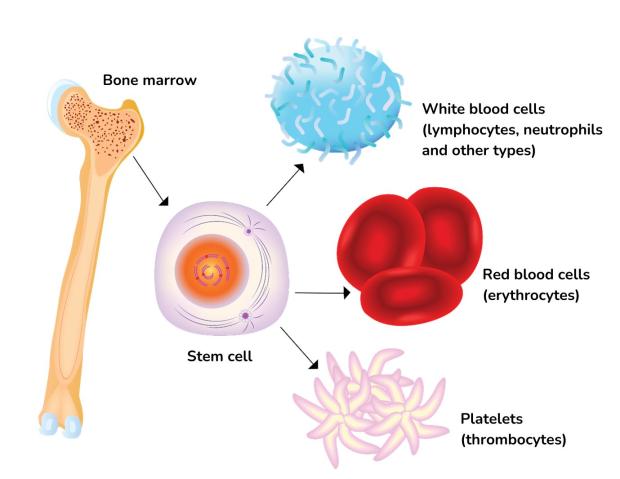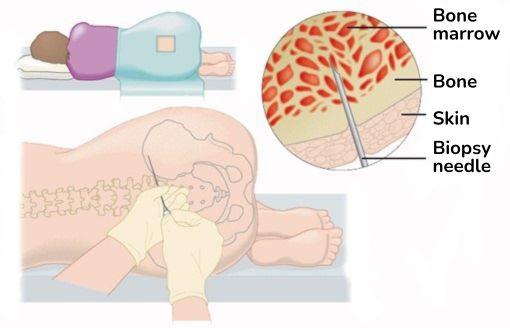Bone marrow biopsy
A bone marrow biopsy is a test to check whether you have lymphoma in your bone marrow.
On this page
Bone marrow is the spongy tissue in the middle of some of the bigger bones in your body, such as your thigh bone (femur), breastbone (sternum), hip bone (pelvis) and back bones (vertebrae). Your bone marrow is where blood cells are made. It contains cells called blood ‘haemopoietic’ stem cells (blood stem cells). Stem cells are undeveloped cells that can divide and grow into all the blood cells you need. This includes red blood cells, platelets and all the different types of white blood cells.

The different blood cells that develop in the bone marrow
What is a bone marrow biopsy?
A bone marrow biopsy is a test that involves taking a sample of bone marrow to be examined under a microscope.
The samples are sent to a lab where an expert examines them. They assess the healthy normal bone marrow cells and also look for any abnormal cells, such as lymphoma cells. If they need more information about the cells in the sample, they might run additional specialised tests.
Who might need a bone marrow biopsy?
Bone marrow biopsies are used to check for lymphoma cells in your bone marrow. Your medical team decides if you need a bone marrow biopsy based on the type of lymphoma you have and the results of your other tests and scans. For some people, a bone marrow biopsy can help diagnose the exact type of lymphoma you have. If you are taking part in a clinical trial, you might be asked to have a bone marrow biopsy before and after treatment
Finding out whether you have lymphoma cells in your bone marrow can help your medical team work out what stage your lymphoma is. The stage tells you how many areas of your body are affected by lymphoma.
A bone marrow biopsy is not always needed. PET/CT scans are often used instead to stage lymphoma. However, you might need a bone marrow biopsy if:
- it’s not clear from your PET/CT scan if you have lymphoma in your bone marrow (this is more common in types of low-grade non-Hodgkin lymphomas such as follicular lymphoma), and
- knowing whether or not you have lymphoma in your bone marrow is likely to change the treatment your medical team recommends.
Sometimes, your team might plan to carry out another bone marrow biopsy after you have completed a course of treatment. This is to check how successful the treatment has been at getting rid of the lymphoma cells.
Having a bone marrow biopsy
Most people who need a bone marrow biopsy have the procedure as an outpatient and do not have to stay in hospital overnight.
Before your biopsy
Your medical team should give you information about having a bone marrow biopsy and anything you need to do to prepare for it. Tell them about any medications, supplements or vitamins you are taking, in case they affect how you need to prepare. You are usually able to eat and drink as normal before the procedure.
You might have blood tests beforehand to check that your blood clots normally. If you take blood-thinning medication, you might need to stop taking it for a few days before the biopsy. Your medical team should give you information about this.
If you feel very anxious about having your bone marrow biopsy, you might be able to have a method of sedation to help you relax during the procedure. Ask your medical team about this beforehand.
Having your biopsy
On the day of your biopsy, the person performing it should explain again why you need one, and what it involves. They should make sure that you are still happy to go ahead and ask you to give your consent. During the biopsy, they should tell you what is happening and anything you need to do.
- First, the healthcare professional helps you get into the right position to have your biopsy.
- Most bone marrow biopsies are taken from the back of your hip bone (pelvis). For this, you lie on your side and curl up, with your knees pulled up towards your chest.
- Rarely, if it is not possible to take a sample from your pelvis, a sample is taken from your breastbone (sternum). In this case, you lie on your back.
- Make sure you’re comfortable before the biopsy starts – you need to keep as still as possible during the procedure.
- The healthcare professional cleans the area of skin where they will take the sample. They then inject a local anaesthetic under your skin. This might sting for a few seconds but then it goes numb.
- When the area is numb, the doctor puts a needle into the bone. They might do this by hand, or they might use a battery-powered needle that looks like a small drill. Once the needle is in the right place, they detach the handle of the needle and attach a syringe.
- The healthcare professional then sucks out a sample of liquid (a ‘bone marrow aspirate’). You might feel a sharp pain or a pulling sensation but it should pass almost immediately.
- Often, a sample of harder bone marrow tissue is also taken (a ‘bone marrow trephine’). If they are doing the biopsy by hand, they use a different needle for this. If they’re using a powered needle, they reattach the drill to take the sample. When the doctor takes the sample of harder tissue, you might feel a dull ache or a pushing sensation. This should also pass quickly.
- The needle is removed and a sterile dressing is applied to the area.
The whole procedure usually takes about 20–30 minutes.

Having a bone marrow biopsy from the hip bone
After your biopsy
You need to lie down for 10 to 20 minutes after having a bone marrow biopsy. A nurse should check your dressing for any signs of bleeding before you get up. You might need to rest in the waiting room to make sure you feel well before you go home.
If you have had a sedative, you will be drowsy for a few hours afterwards. You should not drive home or travel on your own – arrange for someone to take you home. Do not drive or operate machinery for the rest of the day.
The local anaesthetic wears off after a few hours. The area where the needles went in might be sore. If you are uncomfortable, you can take painkillers such as paracetamol for a few days. Ask your medical team for advice if you need stronger pain relief or if the pain continues for more than a few days.
You should leave your dressing on and keep the area dry for at least 24 hours. If the wound starts to bleed, press down on the dressing until it stops. Contact your medical team if the bleeding doesn’t stop when you apply pressure.
Is a bone marrow biopsy safe?
Although having a bone marrow biopsy can be uncomfortable, the procedure is very safe and the risk of serious complications is low. Serious complications are rare but can include infection or bleeding from the area where the bone marrow sample was taken.
Contact your medical team if you develop any of the following:
- fever (temperature above 38°C)
- pain where the sample was taken that gets worse or that lasts more than a few days
- redness or swelling where the needles went in, or discharge from the wound
- bleeding that doesn’t stop when you apply pressure.
Depending on where the sample was taken, it might be difficult for you to see where the bone marrow needles went in. You could ask a relative or friend to check for bleeding or redness.
Your medical team should give you further information on what to look for, when to seek advice, and who to call if you need help.
Getting the results
Your medical team should tell you when to expect the results of your bone marrow biopsy and how you will get them. It can take a couple of weeks for the results to come back, depending what tests are done on the sample. Usually your medical team will arrange an appointment to tell you the results and explain what these results mean for you. Waiting for test results can be a worrying time, but it is important for your medical team to collect all the information they need so they can plan the most appropriate treatment for you.
If you’re feeling particularly anxious, you might find it helpful to contact our helpline team to talk about how you’re feeling.
